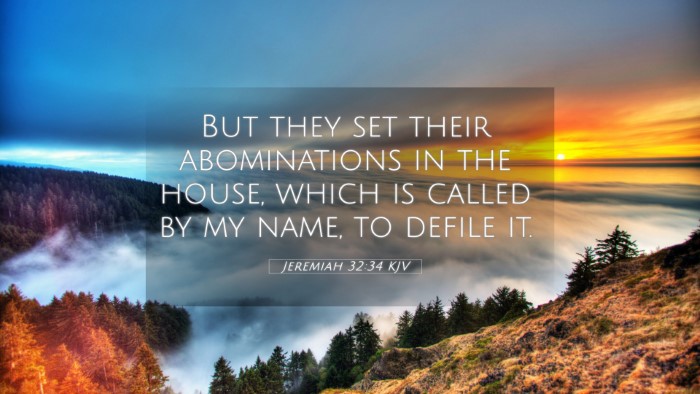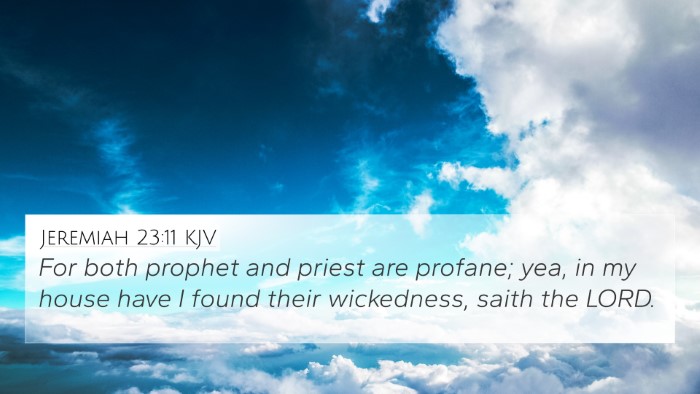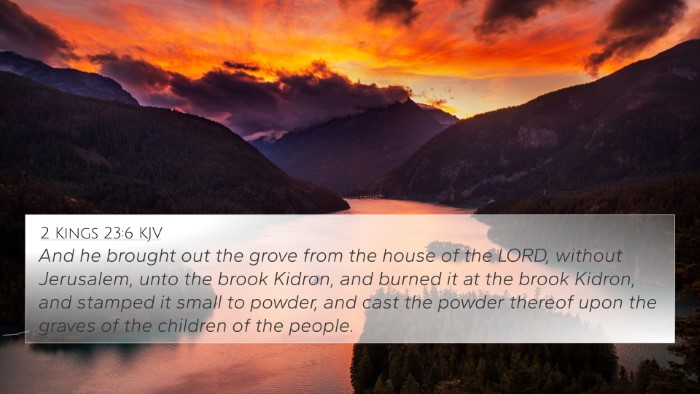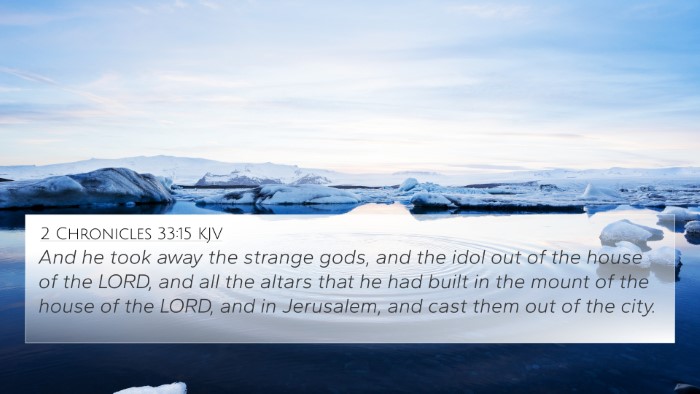Understanding Jeremiah 32:34
Jeremiah 32:34 states: "But they set their abominations in the house, which is called by my name, to defile it." This verse sparks deep theological reflection and provides a profound insight into the nature of sin, judgment, and the sanctity of God's dwelling. By drawing from public domain commentaries like those of Matthew Henry, Adam Clarke, and Albert Barnes, we can unpack the meaning of this verse more thoroughly.
Overview of the Context
Jeremiah, often referred to as the "weeping prophet," delivered God's messages to a nation that was deeply entrenched in sin and idolatry. This particular verse highlights the outrageous act of placing abominable idols within the very temple dedicated to the worship of God. It serves as a critical moment of condemnation where the Lord addresses the corruption not just in society, but within the sacred spaces that should honor Him.
Insights from Commentaries
Matthew Henry
Matthew Henry emphasizes the horror of profaning God’s house. He notes that to set up false gods in the temple is to reject the true worship of the Lord. This act signifies a deep-seated rebellion against God’s commands and signifies spiritual decay within the nation. Henry points out that the temple, symbolizing God's presence, was a holy space meant for worship, and such abominable acts provoke God's severe displeasure.
Albert Barnes
Albert Barnes provides a historical context, reminding the reader of the seriousness of idol worship among the Israelites. He explains that this act not only defiles God's house but also indicates the people's failure to honor God and obey His commandments. Barnes also suggests that the defilement of the temple serves as a warning of God's impending judgment, as He cannot reside in places tainted by sin.
Adam Clarke
Adam Clarke elaborates on the implications of the Israelites' actions by exploring the concept of defilement. He discusses how such acts of impiety reflect a broader narrative of spiritual unfaithfulness and hubris. Clarke indicates that this verse serves as a prophetic forewarning about the consequences of abandoning true worship, and it foreshadows the eventual destruction of Jerusalem and the temple.
Thematic Connections
This verse aligns with several themes in scripture, especially the themes of idolatry, divine judgment, and the sanctity of God's presence. Below are key Bible cross-references that elucidate these themes:
- Exodus 20:3-5 - God's command against idolatry.
- Isaiah 1:12-15 - God's condemnation of false worship practices.
- Ezekiel 8:16 - A vision depicting the abominations occurring in the temple.
- Matthew 21:12-13 - Jesus clears the temple, denouncing its desecration.
- Revelation 21:27 - The purity of God's dwelling place in the New Heaven.
- Jeremiah 7:30-31 - A previous warning about the defilement of God’s sanctuary.
- 2 Chronicles 36:14 - The overall apostasy of the nation leading to exile.
Concluding Reflections
To summarize, Jeremiah 32:34 stands as a gripping account of spiritual violation that carries significant weight even today. It warns believers against the consequences of allowing idols into places meant for God's glory. The reflections from Matthew Henry, Albert Barnes, and Adam Clarke highlight the depth of sin, the nature of God's holiness, and the urgency for repentance. Engaging with this verse through a cross-referenced approach not only illuminates the text itself but also connects it with the broader biblical narrative, demonstrating the continuity of God's message against idolatry.
Using Cross-Referencing as a Tool
Bible cross-referencing is an invaluable tool for deepening one’s understanding of biblical texts. By identifying connections between Bible verses, readers can gain insights into themes and messages that pervade Scripture. A Bible concordance or a Bible cross-reference guide can assist in this exploration, helping to unveil the intricate web of scriptural cross-referencing.
Application in Bible Study
When studying passages like Jeremiah 32:34, employing cross-referencing Bible study methods allows for a comprehensive analysis of related themes and scriptures. This method enriches one's sermon preparation by providing contextual biblical cross-references and identifying Bible verses that relate to each other.
Final Thoughts
Engaging in comprehensive Bible cross-reference materials not only clarifies specific passages but also opens avenues for greater understanding of the overarching message of the Bible. Themes of repentance, restoration, and the holiness of God remain central in our study, reminding us of the profound implications of our worship.









